-
Veveo: More Innovation in Video Search
Innovation in video search continues apace. A new entrant is Veveo, which, upon my first review, looks poised to raise the bar of innovation in this still-evolving space. I spent a couple of hours with CEO/co-founder Murali Aravamudan to learn more about their approach.
I continue to be fascinated with video search and have previously written about current players such as Truveo, blinkx, ClipBlast, Nexidia and TV Guide. I believe video search is the most intellectually challenging part of the broadband video value chain as well as the one with the greatest potential upside for those who ultimately crack this highly complex nut. Video search presents many of the same issues as web search, but layers on additional challenges around relevancy, metadata, user navigation and monetization. Because of the explosion of video choices, users will increasingly rely on video search providers who can expedite retrieval of desired results.
Veveo approaches the key problem of relevancy by trying to emulate some of what's behind Google's vaunted PageRank. As many of you know, PageRank prioritizes relevancy by relying heavily on the number of referring links to a given page. To try to proxy this referral process in the nascent video world, Veveo has developed its algorithms to account for # of people subscribing to a video channel (at say YouTube), user ratings, viewcount, session length and other factors.
Returning relevant results requires a complete index of available video, which has led Veveo to index approximately 125M videos currently. Murali believes is on a par with the established players. The index spans professional video to UGC and short clips to full-length programs.
Though Murali obviously wasn't going to provide too much detail on Veveo's algorithms (not that I'd understand them anyway), their capabilities are on display when running queries at Veveo's beta site located here. Veveo does something I haven't seen elsewhere - notice as you slowly type your query, the search box not only begins autofilling, but new results are also dynamically served up. Even at Google, while the search box will autofill based on Google's anticipation of your intended query, no results are shown until you're done and click enter. For Veveo to be able to do this means its algorithms are both anticipating your query AND simultaneously matching them against its index. Because there are so many videos, Veveo has had to organize them semantically to accelerate the matching process. And don't forget: because there's no client download, the retrieval process is all happening virtually in real time. Admittedly, this process is not being done at scale yet, but Murali is confident that it will perform similarly even when there are millions of concurrent users.
To see what I mean, slowly type "Barack Obama South Carolina Victory Speech" into the search box. By the time you've typed the "t" in South, the most accurate clip (from YouTube) is the 2nd result. When you type "v" in victory it becomes the first. Try the same query elsewhere. You'll get the same results when done, but notice how different the experience is. It's critical to understand that in the search business, the provider's algorithms - which drive accuracy and speed of results - are the two defining competitive advantages. That's how Google blew past all the incumbents, though it was very late to the web search game. Users noticed its supremacy and dramatically drove its awareness and traffic.
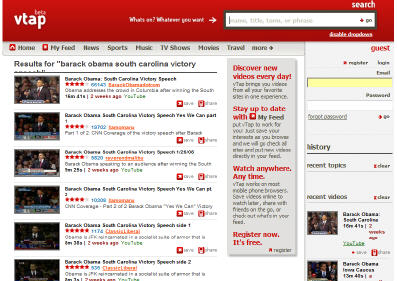 Veveo's business model is to primarily to partner with mobile device manufacturers (it has recently done a deal with Motorola) and CE companies (e.g. broadband-enabled TVs, etc.) to create a vtap network, against which targeted ads will be sold (hey, that sounds familiar). Murali believes there's more upside in that approach than simply licensing the software. However, it will license opportunistically, and from other sources I understand that vtap is powering search for Verizon's FiOS video service.
Veveo's business model is to primarily to partner with mobile device manufacturers (it has recently done a deal with Motorola) and CE companies (e.g. broadband-enabled TVs, etc.) to create a vtap network, against which targeted ads will be sold (hey, that sounds familiar). Murali believes there's more upside in that approach than simply licensing the software. However, it will license opportunistically, and from other sources I understand that vtap is powering search for Verizon's FiOS video service.Lastly, Murali shared with me a draft of a white paper he's written which provides insights from Veveo's video index. It's filled with fascinating statistics (I needed to dust off my old stats textbook to fully understand) about today's video landscape and usage across key sites. I'll have the final paper available for download at VideoNuze when it's ready in a few weeks. Veveo has done two rounds with Matrix, North Bridge, Norwest and OmniCapital, many of the same investors who backed Winphoria Networks, Murali's last company, which was sold to Motorola for $175M in 2004. Veveo is definitely a company worth keeping an eye on.
Categories: Startups, Video Search
Topics: Veveo
-
Jake Sasseville's Mission
Chances are you've never heard of Jake Sasseville. He's looking to change that, and in a hurry.
I caught up with Jake, who is the host of "The Edge with Jake Sasseville," a late-night show that premieres tomorrow night on 40 ABC affiliates around the country. His model offers an interesting case study in how the worlds of TV and broadband are merging. This is opening up lots of new opportunities for talent with the creativity, moxie and financial backing to take advantage.
By way of quick background, Jake is a 22 year-old from Maine who moved to New York and has basically made it his mission to become a big-time multi-platform entertainment personality. He laid the groundwork for The Edge by focusing on YouTube, Facebook, MySpace and the like to begin getting his name out and generate a following. The Edge is part-Letterman, part reality, combining plenty of goofy man-on-the-street interviews with outrageous stunts like taking on a female boxer and stripping down with a nude model. The target audience is clearly 20-somethings looking for a peer to reflect their lifestyles and sensibilities.
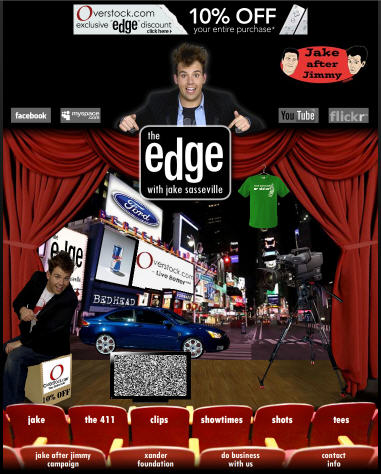
Jake would be just another broadband personality except that now he's self-syndicating The Edge to 40 local ABC stations, paying them somewhere between $150-5,000 per half hour to get his show on the air. He's also been able to convince these stations to give him some on-air promotion and not to list him as paid programming.
Trying to respect his audience's distaste for advertising, he's cut the number of minutes of ads time from 8 to 4 and tried to find sponsors who really want to reach this audience and are willing to be a part of The Edge journey. On board so far are Ford and Overstock, with others in the pipeline. Jake insists that he's not going to get caught in selling on CPMs, but instead is trying to offer sponsors new and creative ways of getting their brands noticed, through additional product placement and multi-platform insertions.
Though he concedes to being short on the specifics of how programming will now flow between on-air and broadband, he's committed to experimenting to figure out what works. For now he understands that TV is better suited to full-length while broadband is better for clips. He has commitments from the 40 stations to do two 13 week series, so the show should be on through the fall. For the first year he doesn't see any big financial gains, rather, it's all about building his brand's awareness with every tool at his disposal.
There has been much speculation about how broadband and TV will merge, yet precious few examples of tight programming integration. Jake is pioneering some interesting terrain with The Edge, which will no doubt yield some key lessons for the rest of the market about how to build an entertainment brand in the broadband era.
Categories: Indie Video
Topics: Jake Sasseville
-
Yahoo Acquires Maven, First Hilmi Ozguc Interview
The rumor mill of the past 2 weeks proved correct, as Yahoo announced this morning that it has acquired
 Maven Networks for $160M. By my count this is the biggest pure-play broadband video deal to date, and is an excellent validation of broadband video's growing importance in the media and technology landscape.
Maven Networks for $160M. By my count this is the biggest pure-play broadband video deal to date, and is an excellent validation of broadband video's growing importance in the media and technology landscape. Hilmi Ozguc, Maven's CEO and co-founder, provided me with an exclusive briefing about the deal, his first comments following the announcement this morning. (As a quick disclaimer, I did some business development and product strategy consulting work for Maven and Hilmi in the company's early days. I didn't have any current financial relationship with Maven.)
As Hilmi says below, and as I've said before (most recently in "My Rant About Super Bowl Ads"), broadband video is increasingly becoming the terrain of the big guys - the biggest brands, publishers, technology providers, networks, etc. As the broadband medium continues to mature, its ability to attract ad
 dollars from incumbent media, particularly TV, is going to strengthen. This process will be accelerated by Yahoo as it seeks to drive Maven's capabilities into its customer and partner base.
dollars from incumbent media, particularly TV, is going to strengthen. This process will be accelerated by Yahoo as it seeks to drive Maven's capabilities into its customer and partner base. Following is a summary of my briefing with Hilmi:
Why did you sell the company?
Broadband video is increasingly going to be a game fought between titans because billions of dollars are at stake and the question is how do you get to the top 50 or 100 global media brands and advertisers? We've focused on building tools and technologies that these media companies need. The time to sell was excellent as was the return for our investors.
Can you describe the sale process?
We had several high profile bidders, although I can't identify them. It was gratifying to see multiple companies validate the product initiatives we put in motion 2 to 2 1/2 years ago. Yahoo has the resources to buy anyone. They took a deliberate approach and looked far and wide and concluded that Maven was the right company to buy. The whole process took several months from start to finish. The deal was for $160M, mostly in cash and it officially closed yesterday.
What group will Maven report into?
Maven will be integrated very quickly and deeply into Yahoo because video is so key to what Yahoo is doing in terms of advertising. This will not end up being a little business unit off to the side somewhere. Our engineering team will be part of Yahoo's engineering team. All Maven executives including me will be staying and have similar responsibilities to what we've been doing. A lot of work has already gone into the integration.
Who do you report into?
I'm not sure I'm at liberty to discuss that, as it would be a little too revealing of Yahoo's strategy, but I think it's in the right place to be within the company.
What does Yahoo bring to Maven?
Enormous reach, 500M visitors around the world per month. An incredible roster of advertisers and publishers who are already in their ecosystem. Interesting and complimentary engineering capabilities. A sheer ability to scale this massively. This deal is all about getting our stuff into the hands of the biggest media, publishing and advertising companies and having it exposed to a massive audience. We started as a media technology company, and evolved to mostly an advertising business. So combining with the leader in display advertising was very logical. Being plugged deeply into a company that sells close to $2B of advertising every 90 days is a huge opportunity for us. It's a massive advertising machine.
Does Yahoo-Maven portend more consolidation?
Absolutely. I just don't see how as a small startup you can have a significant enough piece of the pie when all the giants have now woken up and have video as front and center. Other big players are going to come in more aggressively.
What are the implications of Microsoft's takeover bid of Yahoo on Maven?
We need to stay focused at Maven, and as long as we do that I'm not concerned about any distractions. And I shouldn't really talk about the Microsoft deal either!
What are the 2-3 lessons you've learned about the broadband video market in 5 1/2 years since starting Maven?
When we started virtually nobody really believed in video being delivered on the Internet. We had a singular vision that said, look, once broadband is in enough homes, video is going to take off. So that was our first mission: delivery of bits, playback, HD-quality, etc. As the market evolved, the Akamais of the world solved a lot of the delivery problems, so we shifted our focus to publishing and content syndication, advertising and monetization. Basically, how does a media company generate revenue from broadband? So we evolved along with the market. We tried to stay focused on advertising, professional video and largest media companies.
This is your second successful startup - what lessons do you have for entrepreneurs?
1. Focus is the most important thing and ignoring the naysayers. It's natural to want to hedge, but you have to be bold enough to make decisions. Markets do take time to develop. We were early no question, but the market caught up and we were at right place at right time when it did. 2. Agility is also important and being analytical about what the market is saying. So the ability to shoot a direction and switch. And do it fearlessly. Trial and error is key. 3. Bet on the right people. The wrong people can steer you down the wrong path. So you essentially have to be the world's most capable talent scout, to build a team of people at all levels of the organization. A great team will figure it out.
Where's the broadband video market going from here?
Startups got this space going and created a lot of the core technology and innovation, but this is no longer a game of startups. Big media companies want to deal with big technology companies and networks. Big advertisers want to work with biggest publishers. To achieve this scale independently would be very difficult.
What are the key challenges for broadband video market?
I don't want to say the "R" word that everyone's talking about, but if it comes, I hope it's a mild one. As we know, advertisers cut back quickly in difficult economies. Though I don't think this will happen in broadband because it is so promising and it's still pretty small. Another challenge is getting ad agencies and advertisers to think of broadband as being interactive and capable of more than TV ads. You've talked about that a lot at VideoNuze. And finally the need to scale the technology and infrastructure so it's rock-solid and dependable. That's what Yahoo and Maven will focus tightly on. And I think we have all the tools between us to grab the undisputed leadership position in this, if we move fast enough.
So are you going to do startup #3?
My focus for now is on integration and marshalling all these terrific resources. Yahoo has a great team and has been chomping at the bit to have a competitive video offering to sit alongside their display offerings. They have a killer ad sales force, along with great relationships with the biggest publishers. They have mastered how to play on the media company side, and in being a partner to other media companies. We can't wait to get going.
Congrats again.
Categories: Deals & Financings, Portals, Technology
-
How-to Category Gets Crowded
The Internet's low entry barriers are again at work, this time in the video-based "how-to" category, which has recently attracted a rush of well-funded new competitors. It's no surprise: how many of us would rather watch a video of someone explaining how to do something vs. reading a lengthy and often poorly-written guide?
Like many things in the broadband video world, the players' strategies, content approaches and business models are all over the board. In the ad-supported category, the earliest entrants (and their funding) are ExpertVillage (now owned by Demand Media) and VideoJug ($30M from last May), with HowCast ($8M from Tudor/others), 5Min.com ($5M from Spark Capital) and WonderHowTo.com (undisclosed amount from General Catalyst) launching more recently. Of course there's also YouTube and DIYNetwork from Scripps, with its sister cable channel, and scores of other sites that offer free instructional video. Then in the paid download category there is Zipidee (angel round), which recently acquired TotalVid and iAmplify ($6M from Kodiak). plus countless other video download sites.
One of the lines of demarcation for the ad-supported sites is how they acquire content. Does the video come solely from "experts" or also from the community? For now, it appears that ExpertVillage and VideoJug rely on experts while the other ad-supported upstarts rely on the community as well. I spoke with Ran Harnevo, CEO of 5Min.com, who believes its highly community-oriented focus is a real differentiator. In fact, 5Min bills itself as a "Life Videopedia", a spin on the hugely popular Wikipedia, which demonstrates the power of user contributions.
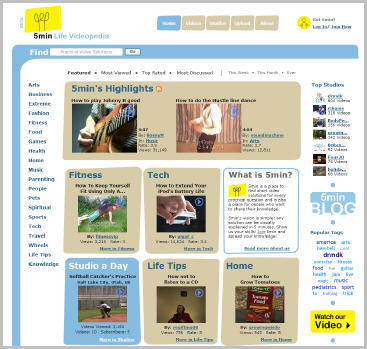
The whole notion that a top-down editorially-driven approach will ever be sufficiently comprehensive seems unlikely, so my guess is that some UGC augment eventually will be required by all players. That means these sites will compete with each other for the best contributors, in the same way that video sharing sites like Metacafe, Veoh, Revver and others compete with each other in general video.
To succeed in this horse race, 5Min's focus is to offer the best overall platform, including a focus on technology. So 5Min provides strong branding opportunities, a revenue share, tools and features and of course, traffic. On the technology side, one differentiator is its "SmartPlayer", which allows zooming, super slow-motion, frame-by-frame and storyboard playback.
One of the main reasons there's so much activity on the ad-supported side is that how-to videos provide highly-targeted and engaged audiences that sponsors crave. At a minimum, marrying these how-to videos to Google AdSense provides a baseline revenue model. But the real opportunity is to aggregate enough traffic in a category to land sponsors who will be prominently featured. So for example, while 5Min already does an impressive 5M views/mo, it will likely need to be in that range per category to appeal to big-name sponsors. The company will begin running ads in Q2, and is focused on display ads and overlays, not pre-rolls, which Ran thinks are too disruptive. To build its traffic it will pursue widgetization, 3rd party distribution and SEO.
All of this how-to activity is clearly going to be a boon for users. Just as the Internet has provided an explosion of information, these video how-to sites will now make doing things a whole lot easier. How to break out of the growing pack will continue to be each how-to site's challenge for the foreseeable future.
Categories: Indie Video, Startups
Topics: 5Min.com, DIY, ExpertVillage, HowCast, Scripps, VideoJug, WonderHowTo.com, YouTube, Zipidee
-
HSN Shops for Broadband Success
Home Shopping Network (HSN) presents an interesting example of a strong incumbent TV-based retailer now seeking to leverage its strengths to succeed in the broadband era. I caught up with John McDevitt, VP of Advanced Services to learn how the company is adapting itself.

For those unfamiliar with HSN, it's the granddaddy of TV shopping services, generating $2B+ annual revenue, with its linear channel now carried by virtually every cable and satellite operator and telco. The Internet has significantly changed the landscape of electronic retailing for HSN, with thousands of e-commerce providers encroaching on HSN's traditional turf. Over the years HSN has continued to bolster its HSN.com web site and do significant cross promotion between on-air and online, to drive awareness and revenues.
With the mass adoption of broadband, HSN has embraced an "everywhere" strategy, comparable to many other content providers. HSN has realized that running a single linear cable channel is no longer sufficient for success. HSN wants to position itself as a credible purchase option wherever the consumer is, offering a simple, straightforward transaction opportunity. The big paradigm shift in broadband is that, while watching HSN on-air is a "destination-experience", in broadband/online, users follow a "product-focused experience." That means that often users come upon HSN not because they are already fans or intended to, but because HSN scored high in search results, particularly in price comparison services.
Delivering a strong video experience is where John sees HSN having a critical advantage given its video heritage. HSN owns all of its video, so it doesn't have any right-related issues. It has built a library of around 25,000 video clips associated with its products; it has already posted over 7,000 of these to YouTube. HSN captures every minute of its on-air experience and every single product on HSN.com has a video associated with it. As John says, shooting great video isn't trivial, between creating the sets, managing the talent and highlighting the product, but these are the things HSN is an expert in. On YouTube in particular, HSN is seeing strong viewership in its channel, with the heaviest action in the health and beauty area, and in how-to related videos.
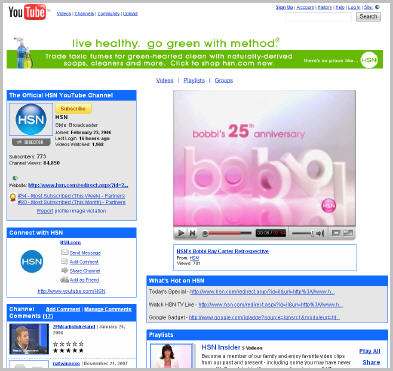 HSN is leveraging its video in lots of other ways as well. It has built out a Media Center edition of its site and also a Silverlight-based version of HSN.tv. In the traditional set-top box realm, it is offering a VOD version and a hugely popular shop-by-remote capability.
HSN is leveraging its video in lots of other ways as well. It has built out a Media Center edition of its site and also a Silverlight-based version of HSN.tv. In the traditional set-top box realm, it is offering a VOD version and a hugely popular shop-by-remote capability.In all of these activities, John says the key lessons have been to keep things quick, easy and convenient for customers (this echoes what Bob Pittman said in his interview 2 weeks ago about the importance of convenience). Users love being in control of their shopping; this alone is a big change for a linear-oriented channel. Nevertheless, HSN seems to be getting it. John espouses a "let's try it and see if it works" mentality at HSN, urging action over inertia. HSN seems like another incumbent determined to adapt itself for the broadband age.
Categories: Cable Networks
Topics: HSN
-
Last Super Bowl Post - I Promise
I promise, this will be my last post on the Super Bowl ads. I suspect some of you are getting sick of hearing about them, but the reality is that there are some cool follow up tidbits emerging that I think many of you will be interested in.

First a clarification. I accidently omitted mentioning Audi as another Super Bowl advertiser that had a broadband component to their ad. Their mention of "TruthInEngineering" at the end of their spot was so quick that I didn't even notice it. That's a shame, because when you visit the mini-site there's a lot of great video, including one lasting 3 minutes all about the making of the ad.
Ken Liebeskind has a good interview with Paul Venables, who is the founder and co-creative director of the ad agency that created the spot and the videos at the mini-site. I really like how well developed the whole "Truth In" concept has been executed in the mini-site. My only gripe with the execution of the TV spot is that just flashing "Truthinengineering.com" at the end for a quick second is insufficient to really optimize traffic flow. Though Venables says traffic is way up since the game, I think it would be far higher had they focused on the URL longer.
Meanwhile, some interesting follow up stats that have bubbled up. comScore is reporting that 13% of Super Bowl viewers watched an ad online and that 13% visited an advertiser's web site. Of those who visited an advertiser's web site, 38% visited GoDaddy.com, 22% Coca-Cola and 21% Pepsi.
YouTube's AdBlitz Gallery provides the number of views for all the ads. The top 5 list is currently: SoBe LifeWater/Thrillicious (740,094),
Derek Jeter/G2 (677,686), Bridgestone/Scream (564,986), ETrade/Talking Baby (530,397) and CareerBuilder/Queen of Hearts (442,273).Lastly, the Cincinnati Enquirer is reporting that MyTalkingStain.com, the mini-site TideToGo promoted, had received 30,000 visits by the end of Sun night and already had 5,500 customized ads created. The UGC contest at the site invites users to create their own spoof of the Super Bowl ad. In my opinion, Tide To Go gets top honors for making all the right moves: A clever game spot. Great promotion to the mini-site. Great engagement opportunities and payoffs for consumers. I think it's a model for future Super Bowl advertisers to follow.
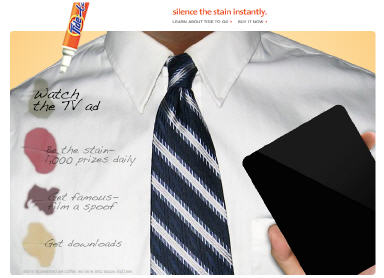
Ok, that's it. Now I'll shut up about Super Bowl ads, until 2009.
Categories: Brand Marketing, Sports
Topics: Bridgestone, CareerBuilder, Coca-Cola, ETrade, G2, GoDaddy, Pepsi, SoBe LifeWater, YouTube
-
AllThingsD.com/VideoNuze
I'm not one to toot my own horn, but in this case I have to make an exception: VideoNuze/Yours Truly have been selected to be included in the "Voices" section of AllThingsD.com. If you're not familiar with AllThingsD.com, it is Dow Jones's flagship media and technology web site, associated with its prestigious "D: All Things Digital" annual conference. It is probably the most sought-after executive event focused on digital media. AllThingsD.com is co-edited by Kara Swisher and Walt Mossberg and is widely read throughout the media and technology industries.
My first post, from this past Monday, "My Rant About Super Bowl Ads" can be seen at the site. It is a real privilege to be selected for the "Voices" section, and I'm completely thrilled!
Categories: Miscellaneous
-
My Reflections on NATPE Conference
Last week's NATPE conference brought numerous opportunities for attendees to learn about broadband and digital media. Based on the Q&A I heard, plus the hallway chatter, there is intense interest - especially from independent producers - about how to take advantage of the rapidly changing video landscape. Today I want to spend a few minutes reviewing some of what I learned at the conference.

A big chunk of my time was spent hosting a day-long Digital Briefing track, during which 10 companies presented for 30 minutes each, back-to-back throughout the day. The companies that presented were:
Leichtman Research Group, Joost, SpotStock.com, Broadband Enterprises, Livid Media, Vuze, Enticent, Teletrax, PermissionTV and Digital Fountain.These companies offered a highly diverse range of products, services and solutions, all aimed at growing the broadband video industry. Joost, Vuze and Broadband Enterprises in particular drew lots of audience questions, focused on distribution and monetization, 2 key items for indie broadband producers. Similarly PermissionTV received lot of interest for how it can help large and small content providers build out their broadband presence. And Digital Fountain's demos of its high-quality video distribution network garnered a lot of attention (btw, it's soliciting participants for its beta trial here).
The other companies also showed valuable products and services: Livid Media demonstrated its personality-based content and Enticent its loyalty programs. SpotStock premiered its new digital stock footage library aimed at helping indie producers quickly and legitimately gain access valuable resources. And Teletrax explained how its watermarking technology helps broadcasters secure and track their digital streams. Last but not least, Bruce Leichtman of Leichtman Research demystified what's really happening with consumer behavior changes based on his firm's extensive market research.
Outside of the Digital Briefings day, the advertising-related sessions provided lots of needed information to attendees about how monetization is unfolding for broadband delivery. I've already written about Shelly Lazarus branded entertainment speech. Tim Armstrong, head of sales at Google provided insights on how the company is approaching YouTube monetization. Another session elicited reactions from big-time brand marketers about issues with pre-rolls and explored alternatives. And as I previously wrote, NBCU's Jeff Zucker delivered a candid wake-up call to the industry about challenges ahead. Even as someone who follows this stuff pretty closely, I thought there was a lot of new info and perspectives being shared.
All in all, these sessions all served as another reminder to me about how broadband video is becoming a vibrant part of the overall economy. There is so much entrepreneurial energy going into developing all the pieces of the overall broadband ecosystem. A consistent theme I heard at NATPE was that people recognize broadband is challenging incumbent media distribution, but it is also expanding producers' options in unprecedented ways. For me that's the real potential ahead.
If you want to discuss the specifics of any of these, just drop me a line!
Categories: Advertising, Events
Topics: Broadband Enterprises, Enticent, Joost, Leichtman Research Group, Livid Media, NATPE, PermissionT, SpotStock.com, Teletrax, Vuze


